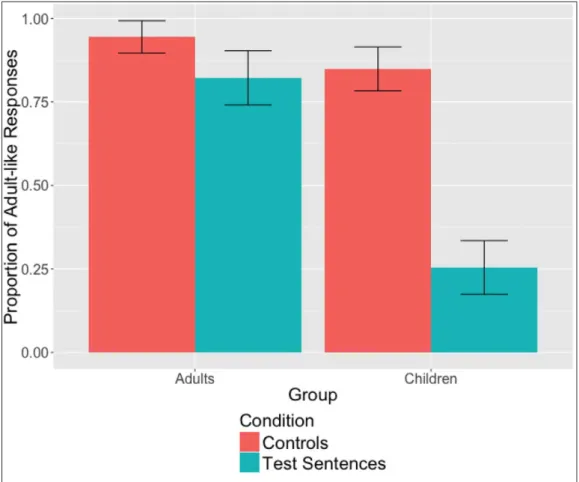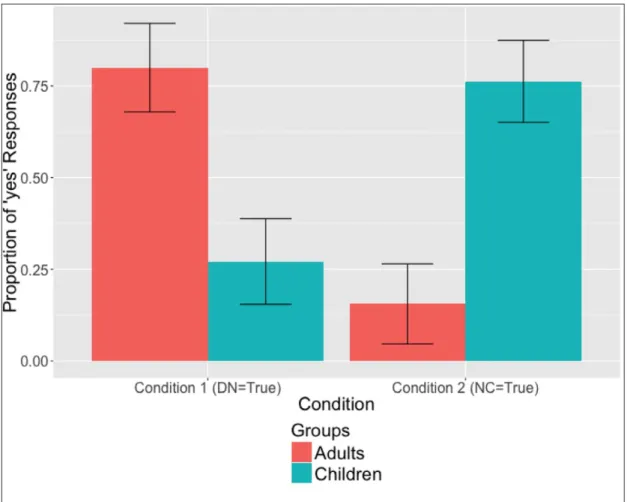11 June 2021
Thornton, R., Notley, A., MOSCATI, V., & Crain, S. (2016). Two Negations for the Price of One. GLOSSA, 1(1), 1-30.
This is the peer reviewd version of the followng article:
Published:
DOI:10.5334/gjgl.4
Terms of use:
Open Access
(Article begins on next page)
The terms and conditions for the reuse of this version of the manuscript are specified in the publishing policy. Works made available under a Creative Commons license can be used according to the terms and conditions of said license. For all terms of use and more information see the publisher's website.
Availability:
This version is available http://hdl.handle.net/11365/1008764 since 2017-05-27T04:11:50Z
RESEARCH
Two negations for the price of one
Rosalind Thornton
1, Anna Notley
1, Vincenzo Moscati
2and Stephen Crain
11 Australian Research Council Centre of Excellence in Cognition and its Disorders (ARC CCD), Macquarie University,
16 University Ave, North Ryde, NSW 2109, AU
2 ARC CCD & University of Siena, Complesso S. Niccolò, Via Roma 56, 53100 Siena, IT
Corresponding author: Rosalind Thornton ([email protected])
Standard English is typically described as a double negation language. In double negation languages, each negative marker contributes independent semantic force. Two negations in the same clause usually cancel each other out, resulting in an affirmative sentence. Other dialects of English permit negative concord. In negative concord sentences, the two negative markers yield a single semantic negation. This paper explores how English-speaking children interpret sentences with more than one negative element, in order to assess whether their early grammar allows negative concord. According to Zeijlstra’s (2004) typological generalization, if a language has a negative syntactic head, it will be a negative concord language. Since Standard English is often analysed as having a negative head, it represents an apparent exception to Zeijlstra’s generalization. This raises the intriguing possibility that initially, children recognize that English has a negative head (i.e., n’t) and, therefore, assign negative concord interpretations to sentences with two negations, despite the absence of evidence for this interpretation in the adult input. The present study investigated this possibility in a comprehension study with 20 3- to 5-year-old children and a control group of 15 adults. The test sentences were presented in contexts that made them amenable to either a double negation or a negative concord interpretation. As expected, the adult participants assigned the double negation interpretation of the test sentences the majority of the time. In contrast, the child participants assigned the alternative, negative concord interpretation the majority of the time. Children must jettison the negative concord interpretation of sentences with two negative markers, and acquire a double negation interpretation. We propose that the requisite positive evidence is the appearance of negative expressions like nothing in object position. Because such expressions exert semantic force without a second negation, this informs children that they are acquiring a double negation language.
Keywords: double negation; negative concord; child language; learnability; negation in English
1 Introduction
In double negation languages, each negation marker exerts semantic force (Zeijlstra 2004; de Swart 2010; Moscati 2006; 2010). In certain linguistic environments, the two negation markerscanceleachotherout,resultinginanaffirmativeinterpretation.Doublenegation languages can be contrasted with negative concord languages. In these languages, sentenceswithtwonegationmarkersmayexpressaninterpretationthatisequivalentto sentences with a single negation.
StandardEnglishisclassifiedasadoublenegationlanguage.Theterm‘StandardEnglish’ isusedheretorefertovarietiesofEnglishthatexcludesentencesthatexpressnegative concord. In double negation languages such as Standard English, double negation is some-timesassociatedwithmetalinguisticnegationorpragmaticnegation.Thisterminology refers to the function of double negation in conversational contexts, which is to correct a
previousutterance(Horn1991;2001;Puskás2012;Blanchette2015).1Puskásillustrates
thecorrectivepragmaticfunctionofdoublenegationwiththeexamplein(1). (1) a. Lenny likes nothing.
b. Lenny does not like nothing.
Theassertionin(1a)iscontradictedbythedoublenegationresponsein(1b),whichcan beparaphrasedas“itisnotthecasethatLennylikesnothing”(Puskás2012:615).Typi-cally,doublenegationisaccompaniedbyaspecificprosodiccontour(Pilaretal.2015).In example(1b),boldfacefontindicatesthatthenegationmarkernot receives stress.
IncontrasttoStandardEnglish,manycontemporaryvarietiesofEnglishexhibitnega-tiveconcord,includingAfricanAmericanEnglish,AppalachianEnglish,bothBelfastand BristolEnglish,andmanyothers(Labov1972;Wolfram&Christian1976;Wells1981; Henry et al. 1997; Martin & Wolfram 1998; Green 2002; 2011). In negative concord dialects of English, double negation interpretations exist alongside negative concord interpretations(Blanchette2013;2015).SeeGreen(2011)foradiscussionofthecoexist-enceoftheseinterpretationsinAfricanAmericanEnglish. AnexampleofnegativeconcordtakenfromLabov’sseminalstudyisgivenin(2)(Labov 1972:804).Theexampleistakenfromaninterviewwitha60-year-oldspeakerfrom Georgia,referredtoasMrs.Gratton.ThisspeakerusedStandardEnglishandsinglenega-tionwithnegativepolarityitemsinthefirst20minutesoftheinterviewbutaswitch inthetopicofconversationto‘bakingwithoutmeasuring’triggeredtheuseofnegative concord. (2) IVer: Doyoumake‘em[biscuits]fromscratch? MrsG: Make‘emfromscratch[chuckle] IVer: Wow!Doyoumeasurethethingswhenyouput— MrsG: Idon’t MrsG: measurenothin’!Ineverhave IVer: Never,evenwhenyoufirst...? MrsG: measure’nothing’.Ihavenevermeasured— Incertainlinguisticcontexts,sentenceswithtwonegationmarkersarepotentiallyambig-uous,havingbothadoublenegationinterpretationandanegativeconcordinterpretation. Thepotentialambiguityfrequentlyariseswhensententialnegationiscombinedwitha secondnegationmarkerthathasbeendrawnfromaparticularsetofnegativeexpressions, called n-words(Laka1990;Giannakidou2005).2Thesetofpotentialn-words in English
includes nobody, nothing, nowhere,
andsoon.Apotentiallyambiguoussentencewithnoth-ingisillustratedin(3).
(3) Johndidn’teatnothingbeforerunningthemarathon.
a. ThereissomethingthatJohnatebeforerunningthemarathon.(DN) b. ThereisnothingthatJohnatebeforerunningthemarathon.(NC)
1 Blanchette(2015)proposesasecondtypeofdoublenegationwhichshetermslong distance DN.Anexample
is John didn’t paint the house with no windows.InlongdistanceDNthetwonegativemarkersareseparated, forexample,byacomplexNPoratensedclausalboundary.Inthispaper,wewillusethetermdoublenega-tiontorefertometalinguisticorpragmaticnegation,asillustratedin(1).
2 Giannakidou(2005)definesn-words, roughly, as words that are used in sentences that also contain
senten-tialnegationand,yet,expressapropositionthatisequivalenttoasinglenegation.Inaddition,n-words can serveasfragmentanswerstoquestions.
Thedoublenegationinterpretationisindicatedin(3a).Thisinterpretationisgeneratedif the negation markers (did)n’t and nothing each exerts semantic force. In this case, the two negativemarkerscanceleachotherout,yieldinganaffirmativeinterpretation.Aspeaker whointendstoconveyadoublenegationinterpretationof(3)isassertingthatJohndid eatsomethingbeforerunningthemarathon.Thedoublenegationinterpretationhasthree furtherproperties.First,thedoublenegationinterpretationof(3)invitesthepragmatic inference that John ate only a small amount. Second, the use of double negation indicates thatthespeakerwasnotinapositiontouseasimpleraffirmativestatementsuchasJohn
ate something before running the marathon, which would have more directly conveyed the
intended interpretation (Horn 1991: 85). Rather, the speaker is revising the previous speaker’sutterance.Third,thedoublenegationinterpretationistypicallyaccompanied bytheplacementofphonologicalstressontheauxiliaryverbandonthesecondnegation marker (nothingin(3)).Thecriticalobservationisthattheexpressionnothing exerts inde-pendentquantificationalforceonthedoublenegationinterpretation.
Aspeakerwhointendsthenegativeconcordinterpretationof(3)isattemptingtoconvey themessagethatJohndidn’teatanythingbeforeheranthemarathon,asindicatedin (3b).Onthisinterpretation,thewordnothing is an n-word,anddoesnotexertindependent negative force. Instead, the n-word nothing agrees with the first negation marker (cf.Zeijlstra2004;2008a;b).
To further illustrate the negative concord interpretation, it is instructive to look at Italian, a negative concord language. In Italian, an n-wordinobject(ordative)positionis unabletoexertindependentnegativesemanticforce.Thisisillustratedin(4),usingthe
n-word nessuno‘nobody’ (theexampleisfromZeijlstra2004:130).Then-word nessuno
‘nobody’agreeswiththenegationmarkernon ‘not’,sonessunoexpressesameaningthat issemanticallyequivalenttoanexistentialexpression,similartoEnglishanybody. If the negation marker nonisremoved,thesentencebecomesunacceptable.
(4) Italian
Gianni*(non)hatelefonatoa nessuno Giannineg has called to nobody ‘Giannididn’tcallanybody’
1.1 Negation in the grammar of English
AdultspeakersofStandardEnglishcanreadilyinterpretnegativeconcordsentenceseven iftheythemselvesdonotproducenegativeconcordsentences.Theeaseincomprehen-sionofthenegativeconcordinterpretationmaybedue,inpart,tothefactthatspeakers ofStandardEnglishhaveabundantexposuretonegativeconcorddialectsinthemedia (e.g., I can’t get no satisfaction).Inthepresentpaper,weofferadifferentexplanationfor theobservationthatadultspeakersofStandardEnglishcanreadilyinterpretnegative concordsentences.ThealternativepossibilityhasbeenraisedpreviouslybyBlanchette (2013)andbyTubau(2008),andentertainedbrieflybyZeijlstra(2004).Theseresearch-ersallproposethatStandardEnglishisinherentlyanegativeconcordlanguage.
A question immediately arises. If Standard English is inherently a negative concord language,whydon’tspeakersofStandardEnglishproducenegativeconcordsentences? One possible answer to this question would point to sociolinguistic factors, such as a social stigma, which some people may associate with negative concord sentences (cf. Nevalainen2006;Horn2010).Indeed,Blanchette(2013;2015)proposesthatStandard English is inherently a negative concord language and observes that sociolinguistic factors maycontributetotheabsenceofnegativeconcordsentencesbyspeakersofthisdialect.
Nonetheless,BlanchettespeculatesthatEnglishspeakerswillnaturallyreverttoanega- tiveconcordinterpretationintheabsenceoftherequisitecontextualsupportandintona-tionthataretypicallyassociatedwiththedoublenegationinterpretationofsentenceslike (3)(Blanchette2013:2).Similarly,Tubau(2008)proposesthatallvarietiesofEnglishare inherentlynegativeconcordlanguages.IncontrasttoBlanchette,Tubau(2008)invokes language-internalfactors,ratherthansociolinguisticfactors,toexplaintheabsenceof negativeconcordproductionsinspeakersofStandardEnglish. Thepresentstudyisanexperimentalinvestigationofnegativeconcordinthegrammars ofchildrenacquiringStandardEnglish.Weexplorethepossibilitythatyoungchildren acquiringStandardEnglishassignanegativeconcordinterpretationtosentenceslike(3) duringtheirearlylanguagedevelopment.IfyoungchildrenacquiringStandardEnglish licensenegativeconcordinterpretationsofsentenceswithtwonegativemarkers,then this would lend credence to the conjecture that Standard English is inherently a negative concord language. 1.2 A typological generalization TheproposalthatEnglishisanegativeconcordlanguagedoesnotfitneatlyintothetypo-logicalgeneralizationreportedinZeijlstra(2004).Basedonasurveyof25languages, Zeijlstra(2004)concludesthatlanguagescanbepartitionedintotwoclasses,depending onthepositionofnegationinthesyntaxoftheselanguages.Thatis,thestructuralposition of negation in the syntactic structure of a language determines how it combines with a secondnegationmarker.Morespecifically,thetypologicalgeneralizationisthefollowing: (5) Ifalanguagehasanegativemarkerthatisasyntactichead,thelanguageexhibits NC(Zeijlstra2004:266).3 Zeijlstra’sgeneralizationisnotbi-conditional,becausenotallnegativeconcordlanguages incorporateanegationmarkerasasyntactichead.Indeed,therearenegativeconcord languageswithjustanadverb(e.g.Quebecois,Bavarian).Nevertheless,ifnegationisa syntactic head in a language, then that language licenses sentences with negative con-cord,accordingtothegeneralizationproposedbyZeijlstra.
Zeijlstra’s typological generalization was incorporated into a binary parameter. One valueoftheparameteryieldsnegativeconcordlanguages.Onthisvalue,negationisasso-ciatedwithformalfeatures[i/uNEG]inthesyntacticcomponent,andrequiresaNegP functionalprojection(Zeijlstra2008a).4Theothervalueoftheparameteryieldsdouble negationlanguages.Onthisvalue,negationisanadverb,adjoinedtovP.Thedouble negationinterpretationisassignedwithinthesemanticcomponent. WehavechosentodescribeZeijlstra’sanalysismainlybecause,withcertaincorollary assumptions,thisparametricanalysiscanbeusedtomakespecificpredictionsaboutthe courseoflanguageacquisition.AccordingtoZeijlstra(2008a),theparameterthatdistin-guishes between negative concord and double negation languages has a default setting. Thedefaultvalueoftheparameterisfornegationtobeanadverb(Zeijlstra2008a).The reason is that the value associated with double negation is more economical, in the sense thatpositingnegationasanadverbdoesnotrequirethelanguagelearnertobuildthe functionalprojection,NegP.Thisfunctionalprojectionisaddedonthebasisofpositive evidence from the language.
3Zeijlstra(2004)arguesthatthisgeneralizationholdsforbothso-calledstrictNClanguages(e.g.,Russian
andGreek)andfornon-strictNClanguages(e.g.,ItalianandFrench).
4 InBiberauer&Zeijlstra(2012),negativeconcordisdefinedfollows:“NCisanAgreerelationinvolvingone
elementbearingaformallyinterpretablefeature[iNEG]andoneormorefurtherelementscarryingunin-terpretableformalfeatures[uNEG]”.
InZeijlstra(2008b),StandardEnglishisanalysedasadoublenegationlanguage,with just one negative marker, the negative adverb, not. In the syntactic framework Zeijlstra proposes,negativeauxiliaryverbsareanalyzedassinglelexicalitems(cf.Pullum&Wilson 1977).Thisanalysisispredicatedontheobservationthatthecontractedformofnegation, n’t,hasarestricteddistribution,aspointedoutbyZwicky&Pullum(1983);itislimited tonegativeauxiliaryverbs.TheanalysisproposedinZeijlstra(2008b)bringsStandard Englishinlinewiththetypologicalgeneralization,asexpressedusingabinaryparameter. IncontrasttotheanalysisproposedinZeijlstra(2008b),manylinguistsanalyzethe contractedformofnegationasasyntactichead(e.g.,Adger2003).Thiswouldmake StandardEnglishanexceptiontoZeijlstra’stypologicalgeneralization,whichproposes that languages with a head form of negation are negative concord languages (Zeijlstra 2004;2008a;b).Acknowledgingthispossibilityinhisdissertation,Zeijlstraremarked that“StandardEnglishisaDNlanguagethatshowsNC-likebehaviorandcanbeconsid-eredasapseudo-NClanguage”(Zeijlstra2004:145).Intheremainderofthepaper,we willsupposethatn’tisaheadformofnegation.WewillthereforeassumethatStandard EnglishrequiresaNegPandwewillinvestigatetheconsequencesofintroducingahead formofnegationforthecourseofchildlanguagedevelopment. TheparameterapproachtakenbyZeijlstra(2004;2008a;b)isnotwithoutitscritics.One lineofresearchnotesthattherearefiner-graineddistinctionsamongnegativeconcord languagesthatneedtobeexplained.Thishasledsomeresearcherstoproposeamicro- parametricaccountofthesyntaxofnegativeconcordlanguages.Accordingtothemicro-parametricaccount,thesyntacticpropertiesofn-words determine the internal syntactic differencesamongnegativeconcordlanguages(Déprez,2012;Depréz,etal.2014). Wereadilyacknowledgethelivedebateinthetheoreticalliteratureaboutthesyntactic analysisofnegationandnegativeconcord,includinganalysesbyBlanchette(2013;2015), Déprez,(2012),Depréz,etal.(2014),Haegeman&Lohndal(2010),andTubau(2008), amongothers.Theaimoftheresearchonchildlanguagethatwereportinthispaper, however,doesnotdependonthedetailsofthesyntaxofnegativeconcordoritssemantics. Itwillsufficeforourpurposestosettleononesufficientlydetailedlinguistictheoryas astartingpointforinvestigatingchildren’sgrammaticalhypothesesaboutnegativecon-cordanddoublenegation.Wehavechosentoframeourexperimentalhypothesesusing Zeijlstra’sanalysisofnegationandnegativeconcordbecauseitwasinvokedinprevious researchtoformulatetestablehypothesesaboutstagesintheacquisitionofchildEnglish. Morespecifically,Zeijlstra’stypologicalgeneralizationmakesaspecificpredictionabout children’sinitialanalysisofnegation,andthesubsequentstageschildrengothroughin convergingontheadultgrammarofnegation(cf.Thornton&Tesan2007;2013). AccordingtoZeijlstra’s(2004)typologicalgeneralization,ifalanguagehasanegative markerthatisasyntactichead,thentheend-productisanegativeconcordlanguage. Therefore,ifthecontractednegativemarkern’t is analysed as a head in English, then StandardEnglishispredictedtobeanegativeconcordlanguage,contrarytoconventional assumptions.Thisledustoconsidertheintriguingpossibilitythat,whenchildrenacquir-ing Standard English take n’t to be a negative head, they will assume that English is a negativeconcordlanguage.Thispossibilityisexploredinourexperimentalstudywith preschoolchildren.Beforeintroducingtheexperiment,wewillreviewthefindingsofpre-viousstudiesoftheacquisitionofnegationinStandardEnglish.Webeginwithareviewof theseminalworkintheacquisitionofnegationbyUrsulaBellugiinthe1960s,andthen reformulatethestagesofacquisitionfirstdocumentedbyBellugi,toputtheminamodern theoreticalperspective.Finally,wewillseehowwellchildren’sstagesintheacquisition ofnegationcomportwithZeijlstra’snegativeconcordparameter(Zeijlstra2004).
2 Literature review
ThefirstdetailedstudyoftheacquisitionofnegationbychildrenacquiringStandardEng-lishwaspresentedinBellugi(1967).TheBellugistudyexaminedthetranscriptsofthe spontaneousspeechofthreechildren,whohavecometobeknownastheHarvardchil-dren(Brown1973).Onthebasisofthetranscriptsofthesechildren’sspontaneousspeech, Bellugi(1967)distinguishedthreestagesofnegation.Atthefirststage,negationwassaid tobeprimitive.Negationwasinstantiatedbytheuseofnot (and, to a lesser extent, no) at thebeginningortheendofwhatBellugitermedthenucleusoftheutterance,whichcould beaword,aphrase,orpossiblyevenasentence.Atthesecondstageofacquisition,nega-tionappearedsentence-internally.Asinstageone,childrencontinuedtousethenegation marker not (and no)atstagetwo.Bellugialsoreportedthat,duringstagetwo,theHarvard childrenproducedtwonegativeauxiliaryverbs,don’t and can’t.Becausethesechildrenall lackedproductiveuseofthecorrespondingaffirmativeauxiliariesdo and can (and other auxiliaryverbs)atstagetwo,Bellugiarguedthatthenegativeauxiliariesdon’t and can’t wereanalyzedbychildrenasfixedforms(butseeSchütze2010foranalternativeview). Finally,atstagethree,childrengainedproductiveuseofbothaffirmativeandnegative auxiliaryverbs.AccordingtoBellugi,childrenatstagethreehadachievedproductiveuse of sentential negation.AdoptingZeijlstra’s(2004;2008a)analysisofnegationinStandardEnglish,Thornton& Tesan (2013) recast the developmental patterns observed by Bellugi using current linguistictheory.Thornton&Tesan(2013)interpretedchildren’searlynegativeutterances atBellugi’sstageoneandstagetwoasaconsequenceofchildrenadoptingthedefault settingofZeijlstra’snegativeconcordparameter.Thatis,childrenwereinitiallyanalyz-ingnegationmarkersasadverbs,whichisthedefaultvalueoftheparameter.Atthese earlystages,childrenacquiringStandardEnglishwereexpectedtolacktheheadform of negation, the contracted form n’t.NotuntilBellugi’sstage3werechildrenexpected tohavefiguredoutthatStandardEnglishhasanegativehead.Bothofthesepredictions wereconfirmedintheThorntonandTesaninvestigations.Thepresentstudyinvestigates children’sinterpretationsofpotentiallyambiguoussentences,withmorethanasingle negationmarker,oncetheyhaveacquiredtheproductiveuseofthecontractednegative marker n’t in negative auxiliary verbs.
Ifweaccepttheconclusionthatbothadverbialnegationandaheadformofnegation co-exist in Standard English, then this suggests Standard English might actually be better characterizedasahybridlanguage,despiteitsusualclassificationasadoublenegation language.Atanyrate,fromthestandpointoflanguagelearning,oneofthetasksconfront-ingchildrenistoincorporatetheheadformofnegationintotheirgrammars.Ifweadopt a(binary)parametricapproach,thenchildrenwillswitchtheparametertothevaluethat generatesnegativeconcordandeliminatepotentialdoublenegationoncetheyincorpo- rateanegativeheadintotheirgrammars.Itisworthconsideringanalternativeacquisi-tionscenario,however.Onthisscenario,childrendonotsimplyabandontheparameter value on which negation is an adverb and thereafter analyze negation as a syntactic head.Rather,childrenmaintainadverbialnegation,butrespondtothepresenceofn’t in the input by adding the NegP projection, which in turn facilitates negative concord (cf. Thornton & Tesan 2013). Children’s grammars would then have the potential to generatebothnegativeconcordanddoublenegationinterpretations.Wereturntothe learnability of these two different acquisition scenarios following the experiments, in theconcludingsectionofthepaper.However,ourexperimentwithpreschoolchildren assumesthefirstscenario,thatchildreninitiallyaccessanegativeconcordgrammar.
For children acquiring negative concord dialects of English the triggering evidence informing children that the local language has formal features for negation and the
functional projection NegP is simply sentences with negative concord in the positive input(Zeijlstra2004).Thefactthattherearetwonegativemarkersinformschildrenthat thattheyneedtobuildaNegPfunctionalprojection,tolicensethenegativeoperator that‘agrees’withthen-wordsinnegativeconcordsentences(Zeijlstra2004;2008a;b). AcquiringStandardEnglishisnotasclear-cut.Sincenegativeconcordsentencesarenot presentintheprimarylinguisticdata,childrenrequireanalternativesourceofpositive evidenceinordertopostulateaNegPprojectiontohostthecontractedformofnegation, n’t.Onepossiblesourceofevidenceisnegativeauxiliaryverbs.Inprinciple,anynegative
auxiliary verb could be taken by children as evidence that n’t is a head form of negation. As we saw, however, the negative auxiliary verbs don’t and can’t maybeanalyzedasfixed formsbyyoungEnglish-speakingchildren.Childrenrequireclearevidencethatthecon-tracted from of negation, n’t,isacomponentpartofthenegativeauxiliaryverb.Thornton& Tesan(2007;2013)proposedthatthemulti-morphemicnegativeauxiliaryverbdoesn’t providesthemostsalientevidenceinformingchildrenthatn’t is a head form of negation, giventhatthe3rdpersonagreementmarkerisinternaltotheword.
Despitethefactthatthenegativeauxiliaryverbdoesn’t is likely to be abundant in the inputtoEnglish-speakingchildren,theempiricalfindingsfromtheThorntonandTesan (2007;2013)studiesrevealedthatchildrenoftentakeconsiderabletimebeforetheypro-duce doesn’t.Supposingthattheproductiveuseofdoesn’t is indicative of the head form ofnegationinchildren’sgrammars,thefindingsfromthesestudiessuggestthattheNegP projectionisintroducedintosomechildren’sgrammarswhentheyareasyoungas2;6, andotherswhentheyareasoldas3;6.Mostimportantly,theThorntonandTesanstudies documentedadramaticchangeinchildren’sgrammarscloselyfollowingontheheelsof theproductiveuseofthenegativeauxiliaryverbdoesn’t.Soonafterchildrenbeganpro-ducing doesn’t, they abandoned the use of not in negative sentences.5Children’snon-adult
negativesentenceswererapidlyreplacedbysentenceswiththesamecolloquialnegative auxiliary verbs used by adults.
Thisbringsusbacktothetopicofthepaper–whetherStandardEnglishisinherentlya negativeconcordlanguage.AccordingtoThornton&Tesan(2013),whoassumeZeijlstra’s negativeconcordparameter,oncechildrenproducethecontractedformofnegation,n’t, andhaveaddedtheNegPfunctionalprojection,theirgrammarshavethepotentialto generatenegativeconcordsentences.Previousresearchprovidesonlyanecdotalevidence thatEnglish-speakingchildrengeneratenegativeconcordsentences,possiblyeveninthe absenceofsuchsentencesintheprimarylinguisticdata.Someoftheanecdotalevidence canbefoundinBellugi(1967),whoobservedthattwooftheHarvardchildren,Adamand Sarah,producednegativeconcordsentences. ThenotesthataccompanytheAdamcorpusstatethatAdam’sparentsspokeStandard English.SarahcamefromaworkingclassfamilyandBellugiobservedthatSarahpro-duced some nonstandard lexical items. However, Bellugi does not state whether or notSarah’sparentswerespeakersofanegativeconcordlanguage.Thispossibilitywas assessed by Miller (2012) who documented the existence of negative concord sentences inthetranscriptsofthespeechbySarah’sparents,althoughSarahproducedfarmore sentenceswithnegativeconcordthanherparentsdid.WewillthereforeconsiderSarah tobeacquiringanegativeconcorddialectofEnglish,andAdamtobeacquiringadouble negationdialect.ExamplesofnegativeconcordstructuresproducedbySaraharegiven in(6),andexamplesfromAdamappearin(7).
5More accurately, children abandoned the use of not insentenceswhereadultsprefertousedoesn’t.Wedo
not know whether children continue to use notinothersentences,suchasoneswiththecopula,whereit is natural (e.g. John’s not a student).Possibly,childrentemporarilyrefrainfromusingnot altogether, until theyconfirmthatthelocallanguagepermitsboththeheadandtheadverbformsnegation.
(6) a. Sheisnothavingnopicnic. (3;11)file40 b. Ijustdon’twantnothinginthere. (4;0)file42 c. Idon’twanttosharenoneofmybooks. (4;6)file49 d. I’mnotscaredofnothing. (4;7)file51 (7) a. Ididn’tdonothing. (3;5)file63 b. Ididn’tcallhimnothing. (3;8)file72 c. Becausenobodydidn’tbrokeit. (4;5)file107 d. Idon’tthinkIcandothisnomore. (4;8)file121 Asnotedearlier,sentenceswithnegativeconcordareequivalentinmeaningtosentences thatcontainexistentialexpressionsinthesamepositionasn-words.Forexample,onthe negativeconcordinterpretation,thesentenceI didn’t see nobody is truth-conditionally equivalent to the sentence I didn’t see anybody. To investigate the parallels between Sarah’suseofnegativeexpressionsandheruseofexistentialexpressions,Miller(2012) searchedSarah’stranscriptsforsentenceswiththenegationmarkers:no, no one, nobody,
nothing and none,
aswellasforsentenceswiththecorrespondingexistentialexpres-sions, any, anyone, and anything.ThemainfindingwasthatSarahusednegativeconcord sentenceswithnegationmarkers65.43%ofthetime,whereassheproducednegative sentenceswithexistentialexpressions34.57%ofthetime.Sarahclearlydistinguished negative concord from negative sentences with existential expressions, and she pre-ferredtousenegativeconcordsentences,attherateofabout2:1.Interestingly,Sarah’s parentsexhibitedtheoppositepattern.Theyproducednegativesentenceswithexisten-tialexpressions,suchasany,morefrequentlythannegativeconcordsentences.Miller speculatesthatSarah’sparentsfavoredexistentialexpressionsovernegativeconcord structuresbecausetheyknewtheywerebeingrecorded.Ifso,thetranscriptsofSarah’s parents may underestimate the input of negative concord sentences that Sarah was exposedto.ThesamedoesnotapplytoAdam,however,sinceAdam’sparentsreport-edlyspokeStandardEnglish. Somefurthersupportfortheconclusionthatnegativeconcordcouldbeadefaultsen-tencestructurecomesfromthefindingsoftwostudiesof5-yearoldchildrenacquiring AfricanAmericanEnglishinastudybyGreen(2011)andinanotherstudybyColes- White(2004).Thefindingsoftheseinvestigationsindicatethat,byage5,childrencom-mandproductiveuseofsentenceswithnegativeconcord,andaccessnegativeconcord interpretationsofsentenceswithtwonegationmarkers.Thereisnodiscussionofthe ageoffirstemergence,however.Sentenceswithnegativeconcordhavealsobeendocu-mentedinchildrenacquiringBelfastEnglish(Henryetal.1997)andBristolEnglish (Wells1981).AstudybyHenryetal.(1997)reportsthatchildrenacquiringBelfast Englishproducesentenceswithnegativeconcordat3;3yearsofage,whilesentences withnegativeconcorddonotappearinthespeechofchildrenacquiringBristolEnglish until4;6years.Thefindingstodate,therefore,donotpermitustopaintaclearpicture of the emergence of negative concord structures in child language, so the jury is out astothestatusofnegativeconcordsentencesinthegrammarsofchildrenacquiring Standard English.
Turningtodoublenegationsentences,Bellugi(1967)reportsthatshedidnotfinda singlesentenceofthiskindinthetranscriptsofthethreechildrenshestudied.Likewise, childrenintheColes-White(2004)studyshowedamarkedpreferenceforthenegative concord interpretation of potentially ambiguous sentences. It is of interest that there wasnosignificantdifferenceinthechildrenwhospokeStandardAmericanEnglishand
AfricanAmericanEnglish.Thefactthatthechildrenpreferredthenegativeconcordinter-pretationwastakenbyColes-Whitetosuggestthatchildrenfinditdifficulttocompute doublenegationinterpretationsduetotheirinherentcomplexity.Forthisreason,Coles-Whitespeculatesthat“redundantinformationiseasiertoprocessthanadditionalnegative information”(Coles-White2004:218). Thepossibilitythatchildrenfinddoublenegationinterpretationsmoredifficultthan negativeconcordinterpretationswasalsoraisedinastudybyJou(1988).TheJoustudy testedchildrenacquiringMandarinChinese,adoublenegationlanguage.Themainfind-ingwasthatchildrenyoungerthan7-years-oldhaddifficultycomputinganinterpretation forsentenceswithtwonegationmarkers.However,alaterstudybyZhouetal.(2014) foundthat,withappropriatecontextualsupport,even5-year-oldMandarinspeakingchil- drenwereabletoaccessthedoublenegationinterpretationofsentenceswithtwonega-tionmarkers.Nevertheless,itisimportanttobecognizantofthedifficultiesthatchildren mayexperienceinattemptingtocomputethemeaningsofsentenceswithmorethanone negation,atleastintheabsenceofcontextualsupport.Thisfactorwillbeincorporated intothecontrolitemsinourexperiment. Basedonthefindingsfromthepreviousliteratureontheacquisitionofnegation,we cannotreachadefinitiveconclusionabouttherelationshipbetweennegativeconcordsen-tencesintheparentalinputandinthespontaneousspeechofchildrenacquiringStandard English.Weaddressedthisissueintheexperimentdescribedinthenextsection.
3 Experiment
PreviousresearchintheoreticallinguisticsbyZeijlstra(2004),Tubau(2008)andBlan-chette (2013; 2015) all raises the possibility that Standard English is underlyingly a negativeconcordlanguage.BuildingonpreviousresearchbyZeijlstra,ourexperimental hypothesiswasthat,oncechildrenacquiringEnglishhaveaddedthecontractednegative marker n’t intotheirgrammars,theyarecapableofassigningnegativeconcordinterpreta-tions to sentences with two negaintotheirgrammars,theyarecapableofassigningnegativeconcordinterpreta-tions inside the same clause.The experimental hypothesis anticipates that when children are presented with sen- tencesthatareambiguousbetweenanegativeconcordinterpretationandadoublenega-tion interpretation, preschool children may assign negative concord interpretations of ambiguoussentences,whereasadultswillassigndoublenegationinterpretations.Thenull hypothesisisthatEnglishisadoublenegationlanguageforbothchildrenandadults.Ifso, thenbothchildrenandadultsareexpectedtoassignthesamedoublenegationinterpreta-tionstothepotentiallyambiguoustestsentencespresentedintheexperiment.Onemight expect moreover, on the null hypothesis, that children would assign double negation interpretationsevenmoreoftenthanadultsdo,sinceadultswillhavehadmoreexposure tonegativeconcordinterpretations,inthemedia,forexample.
Potentiallyambiguoustestsentenceswereusedtoprobetheinterpretationsassignedby bothchildrenandadults.Thetestsentencescontainedtwonegativemarkers,sentential negation followed by nothing.Anexampleis(8).
(8) Thegirlwhoskippeddidn’tbuynothing. a. Thegirlwhoskippedboughtsomething.(DN) b. Thegirlwhoskippedboughtnothing.(NC) Asindicatedin(8a)and(8b),thetestsentenceswerepotentiallyambiguousbetweena doublenegation(DN)interpretationandanegativeconcord(NC)interpretation,andthe experimentalcontextsprovidedtherequisitesupportforbothoftheseinterpretations.If childrenacquiringStandardEnglishinitiallyadoptagrammarthatgeneratesnegative
concordinterpretations,childrenshouldbeexpectedtoassigntheinterpretationin(8b). However, if children acquiring Standard English initially posit grammars that do not permitnegativeconcordjustlikeStandardEnglishspeakingadults,bothchildrenand adultsshouldassigndoublenegationinterpretationsasin(8a). Thestudyincludedacontrolcondition,whichincorporatedsentenceswithtwonega- tionmarkerssuchas(9).Thesesentencesevokedneitheradoublenegationinterpreta-tionnoranegativeconcordinterpretation.Thecontrolsentencesweredesignedtosee whetherornotthechildparticipantsexperiencedifficultiesinprocessingsentencesthat containtwonegations.Thatis,thecontrolsentencescontainedtwonegativemarkers,but didnotlicensea(pragmatic)doublenegationinterpretation.6 (9) Thegirlwhodidn’tskipboughtnothing. Thecontrolsentencesweredesignedtoresemblethetestsentencesascloselyaspossible. Themaindifferenceisthesurfacesyntacticpositionofthetwonegativemarkers.Inthe testsentences,bothnegativemarkersappearinthemainclause(i.e.,....didn’t buy
noth-ing).However,inthecontrolsentences,onenegativemarkerappearsinthemainclause,
andtheotherappearsinsidetherelativeclause(i.e.,...who didn’t V bought nothing). Bypositioningthenegativemarkersindifferentclauses,then-word nothing exerts inde-pendentquantificationalforce.Thus,inourcontrolsentences,eventhoughtherearetwo negativemarkers,themainclausecontainedjustonenegation,andapragmaticdouble negation reading is excluded. We were led to predict, therefore, that children whose grammars assign a negative concord interpretation to the test sentences, such as (8), should,nevertheless,assignthesameinterpretationasadultspeakersofStandardEnglish dotocontrolsentenceslike(9). Thecontrolsentenceswereintroducedtoexcludetwopossibleconfoundingfactors. Basedoneitherofthesefactors,childrenmightproduceresponsesthatappeartobe derivedbyanegativeconcordgrammarwhen,asamatteroffact,children’sgrammars onlylicenseddoublenegationinterpretations.Onesourceofchildren’sapparent,but notreal,negativeconcordresponsescouldstemfromdifficultiestheyexperiencein interpretingsentencesthatcontaintwonegativemarkers,duetoprocessinglimitations suchasverbalworkingmemory(cf.Déprez,etal.2015).Thecontrolsentenceswere includedtoguardagainstthispossiblesourceofchildren’snon-adultresponsestothe test sentences. Thecontrolsentencesenabledustocontrolforanotherpossibleconfoundingfactor. Thisisthepossibilitythatchildrenmistakenlyanalyzethewordnothing as an existential expression,withameaningequivalenttosomething or anything.Children’sadult-likeinter-pretationsofwordslikenothingincontrolsentenceslike(9)wouldnullifythispossibility. Correctresponsestothecontrolsentenceswoulddemonstratethatchildren,likeadults, know that words like nothingexertindependentsemanticforce,unlesstheyagreewith asecondnegationinthesameclause.IfchildrenacquiringStandardEnglishcorrectly interpretthewordnothing insentenceslike(9)but,nevertheless,takeittobeanagree-ingnegativeelementinsentenceslike(8),thenthisthiswouldaddtotheweightofthe evidencethatchildrenacquiringEnglishinitiallypositagrammarthatlicensesnegative concordinterpretations. Insummary,children’scorrectresponsestothecontrolsentencesindicate,first,that theyareabletoprocesssentenceswithtwonegationsand,second,thattheydonotana-lyze words like nothingasexistentialexpressions(something, anything). If we assume that
6 AccordingtoBlanchette’s(2015)terminology,thecontrolsentencesareinstancesoflongdistancedouble
children initially have a negative concord grammar, then the fact that words like nothing exertindependentsemanticforceinthecontrolsentencesprovideschildrenwithevidence (what are called detectable errors in the learnability literature) that they must jettison theirinitialnegativeconcordgrammarinfavorofadoublenegationgrammar.Further evidenceisprovidedbyfilleritemsthatwereincludedintheexperiment.Therewere 3simplesentencefillerslike(10)includedinthetestbatteryfortheparticipants;the other3fillerscontainedsomething. (10) Theboyboughtnothing. Inthefillersentencein(10),thewordnothing hasindependentnegativequantificational force.Accordingtotheexperimentalhypothesis,thechildparticipantswerepredictedto assignanegativeconcordinterpretationtothetestsentences.Wealsoanticipatedthat childrenwouldassignanadult-likeinterpretationtofillersentencessuchas(10)because thereisnoobviouswayforchildrento‘misinterpret’them.Thereforewepredictthat childrenwillsuccessfullycomputeanadult-likeinterpretationforthefilleritems,butmay generateanon-adult(negativeconcord)interpretationofthetestsentences.Ifthispat-ternisobtained,thenthiswouldsupporttheconclusionthatchildren’sgrammarspermit anegativeconcordinterpretationofthetestsentences,butarenotundulyinfluencedby theburdenofprocessingsentenceswithtwonegationmarkers.
Because the control sentences and the filler sentences use words like nothing that have independentnegativesemanticforce,thesematerialspotentiallybiasthechildparticipants towardsassigningadoublenegationinterpretationofthetestsentences,ifthisinterpretation waspossibleintheirgrammars.Puttingittheotherwayaround,thecontrolsentencesandfill-ersdisfavoredtheexperimentalhypothesis,therebyreducingthelikelihoodofaType1error.7 Wewishtonoteonefurtherfeatureofourexperimentaldesignthatwasincludedto avoidType1errors.Wepresentedthetestsentencestobothchildrenandadultswithneu-tralprosody.Previousresearchhasfoundthatchildrenarenotsensitivetoprosodiccues asanindicationofthespeaker’sintendedmeaning,whereasadultsarehighlysensitiveto suchcues(e.g.,Halbertetal.1995;Gualminietal.2003).Therefore,thepresenceofpro-sodiccueswouldbeunlikelytoinfluencechildren’sinterpretationofthetestsentences, butwouldhavehadastronginfluenceontheinterpretationsassignedbyadults.Hadwe chosentousetheprosodytypicallyassociatedwiththedoublenegationinterpretationin the test sentences, then adults (but not children) would have been biased to assign the doublenegationinterpretation(cf.Pilaretal.2015).ToavoidaType1error,weused neutralprosody.Infact,ithasbeensuggestedbyBlanchette(2013)that,intheabsence ofstressonthesecondnegativemarker,adultsfavoranegativeconcordinterpretation. Ifthisiscorrect,thentheexperimentbiasedadults,butnotchildren,towardsanega-tive concord interpretation. The experimental hypothesis was, Blanchette’s suggestion notwithstanding,thatadultswouldassigndoublenegationinterpretationtothetestsen-tences,whereaschildrenwouldassignanegativeconcordinterpretation.8
3.1 Participants
Twenty-four English–speaking children participated in the experiment. The children rangedinagefrom3;6–5;8withameanageof4;7.Thechildrenwererecruitedfrom threechildcarecenterssituatedeitherontheuniversitycampusorcloseby,andallofthe 7AType1erroriscommittedwhenanexperimentisdesignedsothattheexperimentalhypothesisisfavored. 8Asareviewerpointsout,wedonotyethaveinformationfromexperimentalinvestigationsaboutthedegree towhichintonationdoesordoesnotinfluencedoublenegationinterpretationsineitheradultsorchildren, sothisremainsaquestiontobeansweredinfutureresearch.
childrenweremonolingualspeakersofAustralianEnglish.AustralianEnglishconforms to other global versions of Standard English in disallowing negative concord (Newbrook 2001).Wehadnoreasontobelievethatanyofthechildparticipantswereexposedto negativeconcordinthehome.Theadultcontrolswhoparticipatedinthestudywere 15undergraduatestudentsatthesameuniversity.Theadultparticipantsallcompleteda languagebackgroundquestionnaire,andonlythoseadultparticipantswhoweremonolingual speakersofAustralianEnglishfrombirthwereincludedinthestudy.Alloftheadult controlparticipantsweretakingafirst-yearlinguisticscourse,andreceivedcoursecredit fortheirparticipation.9 3.2 Procedures Thetaskusedtoprobechildren’sinterpretationsofsentenceswithtwonegativemarkers wasthedynamicversionofthetruthvaluejudgmenttask(Crain&Thornton1998).The truthvaluejudgmentmethodologyinvolvestwoexperimenters.Oneexperimenteracts outstorieswithtoycharactersandprops,andtheotherplaystheroleofapuppetwho watchesthestoriesalongsidethechild.Intheversionofthetaskusedinthisexperiment, theexperimenteractingoutthestoriesposedaseriesofthreequestionstothepuppet,and thepuppetprovidedanswerstothesequestions.Afterthepuppetproducedeachanswer, thechildwasaskedifthepuppethadgiventherightanswerornot.Thechild’s‘Yes’or ‘No’responsesweretakenasindicationsofhowthechildunderstoodtheexperimental context.Ifthechildinformedthepuppetthathewaswrong,thenthechildwasaskedto explaintothepuppet“whatreallyhappened”inthestory.Thechild’sjudgmentofthe sentenceastrue(“Yes”)orfalse(“No”)andthechild’sjustificationoftheirrejectionsof the target sentences were used to infer if the child had accessed the negative concord interpretationorthedoublenegationinterpretation. Theexperimenterwhoplayedtheroleofthestorytellerdidnotdescribethestoriesfrom theirownperspective.Rather,thestorytelleractedoutthestoryandmadethecharacters dothetalkingastheeventsunfoldedinrealtime.Thismeantthatthestorytellerexperi-mentermemorizedthedialogueaheadoftime,anddidnotreaditverbatim.Thisstep wasimportanttoengagethechildparticipants.Theexperimenterplayingtheroleofthe puppetdeliveredthetestsentencesindividuallyforeachchildwithaneutralintonation contour.Again,tokeepthechildengaged,wechosetodeliverthetestsentenceslive, ratherthantopre-recordthem,andplaythembackonarecordingdevice.Inthisway,we couldensurethatthepuppetrespondedtotheexperimenter’squestionsimmediately.Any delaywouldhavemadeitdifficultforthechildtomaintainthetestsentencesinworking memory, in order to judge their truth or falsity.
Beforecommencingatestsession,eachchildsubjectwasintroducedtoourpuppetand giventwopracticeitems.Ononepracticeitemourpuppetmadeanobviouslytruestate-ment about a story, and on the other he made an obviously false stategiventwopracticeitems.Ononepracticeitemourpuppetmadeanobviouslytruestate-ment about the same story.Thiswassothatthechildsubjectswouldknowthatthepuppetcouldsaysome-thingwrongandtofamiliarizethemwiththetask.Providedthatthechildrenperformed correctlyonthepracticeitems,thechildproceededtothemaintask.Thechildrenwere testedindividuallyandtheirspokenanswerswereaudiorecordedforlateranalysis. Theadultparticipantsweretestedonthesameexperimentalstoriesinsmallgroups ratherthanindividuallyandtheyrecordedtheirjudgmentsofthepuppet’sstatementsas trueorfalseonawrittenscoresheet.Aswiththechildparticipants,theadultparticipants wereaskedtojudgethetruthofscenariosactedoutwithtoysandprops.Atthestartof 9ThestudywasapprovedbytheHumanResearchEthicsCommitteeatMacquarieUniversity(ReferenceNo. 5201200478),andallparticipants(ortheirparents)gaveconsenttoparticipate.
thesession,followingcommonpractice,weexplainedtotheadultparticipantsthatthe experimentwasdesignedasanexperimentforchildren,andthatwewantedthemto seethesamestoriesthatwepresentedtochildren,sothatwecouldcomparechildren’s responsestothoseofadults.Wedidthisbecausewewantedbothchildrenandadultsto bepresentedwiththeidenticalmaterialsunderthesameconditions.Apotentialconfound isthatadults’responsescouldhavebeeninfluencedbyanysocialstigmathatadultpar-ticipantsmighthaveassociatedwithnegativeconcordsentences.10 3.3 Materials Theexperimentaltaskconsistedof6stories,eachbuiltaroundathemesuchasanimal preschool,theprincesses’partyandsoon.Eachstorywasfollowedby3itemsforthe childtojudge;atargetsentencelike(8),acontrolsentencelike(9)andafilleritem like(10).Thestoriesdevisedforthetestsentencesweredividedinto2conditions.In one condition, the test sentence at the end of the story was true on a double negation interpretation,butfalseonanegativeconcordinterpretation.Thisconditioniscalled Condition1.Intheothercondition,thetestsentencewastrueonanegativeconcord reading,butfalseonadoublenegationinterpretation.ThisiscalledCondition2.There were3testtrialsineachcondition. Thecontrolsentencesweredesignedtoensurethatchildrenwereabletoprocesssentences with2instancesofnegation.Therewere3truecontrolsand3falsecontrolsentences.The filleritemsweresimpleaffirmativeornegativesentencesthatprovidedanequalnumberof “Yes”and“No”responses.TheexperimentalitemsaregiveninAppendixA. First,wewillillustratetheexperimentalmaterialsusinganexamplestoryfromeach condition.Below,wegivetheplotline.Thedetailedscriptsforthestoriesareprovidedin AppendixB.
3.3.1 Condition 1: Double Negation True, Negative Concord False
Twogirlsareplayingathome.Oneispracticingskippingtricks.Sheinvitestheother girltojoinher,butthesecondgirldoesn’twanttoskip.Instead,shewantstogooutto buysomeflowersfortheirmum’sbirthday.Thesecondgirlleaves,butonherwaytothe flowershopshemeetsafriendatacaféandstopstohaveadrink.Meanwhile,ayoung boycomesbytheflowershopandbuysabouquet.Thereisnowonlyonebouquetleftat theshop.Justthen,theskippinggirldecidesshe’spracticedenoughtricks,andshewants torushtotheshopsbeforeclosingtime.Shegoesstraighttotheflowershopandbuysthe lastbouquet.Thegirlatthecafé(thegirlwhodidn’tskip)suddenlyremembersshehas togettotheflowershop,butwhenshearrivestherearenoflowersleft,sosheendsup buying nothing. ThesituationattheendofthisstoryisillustratedinFigure1below. Afterthisstorythepuppetwasaskedanexplicityes/no-question,towhichhereplied usingoneofourtestsentences,asin(11).Thissatisfiedthepresuppositionfordouble negation, that is, that there was someone who may have bought nothing and that this is being challenged. (11) Experimenter: Inthatstory,didthegirlwhoskippedbuynothing? Puppet: Thegirlwhoskippeddidn’tbuynothing. 10 Asananonymousreviewerpointedout,thisexperimentalproceduredoesnotbuildinanassessmentof whetheradults’responsesareinfluencedbyaprescriptivebanagainstnegativeconcordinStandardEng-lish.Furtherstudiesusingmoresensitivedependentvariables(e.g.reactiontimes,eye-movements)could helptoaddmoreevidenceaboutthetime-courseofprocessingourexperimentalsentencesandtheirstatus in the adult grammar.
InCondition1stories,thepuppet’sstatementwastrueonadoublenegationreading; itwastruethatthegirlwhoskippedhadboughtsomething.Inaddition,thesentence wasfalseonanegativeconcordreading;itwasfalsethatthegirlwhoskippedbought nothing.Sincethedoublenegationreadingwasthe“Yes”answer,itwasassumedthat childrenwouldaccessthisreadingifitwasavailable,inaccordwiththePrincipleof Charity. The Principle of Charity is a pragmatic principle according to which hearers assume that speakers’ statements are true, unless there is evidence to the contrary (Davidson1984).
3.3.2 Condition 2: Double Negation False, Negative Concord True
Twomiceandacatareattendinganimalpreschool.Atschooltheteachersuggeststhat theanimalchildrencaneitherchoosetoplayinthedress-upscornerorthecookingcorner beforemorningtea.Onemousedecidestodressup.Thecatandtheothermousedecide todosomecooking.Therearesometoycakesandpizzastochoosefromandonecook-ingbowl.Thecattakesthecakeandthebowl.Themousewhodecidedtocooktakesthe pizza,buthasnodishtocookitin.Hethinkshemightnotbeabletocook,andheasks theteacherwhattodo.Shelooksinherstoreroomandfindsanotherdishforhim,sohe candohiscookingafterall.Meanwhile,themousewhodecidedtodressuphasfinished andthereisstilltimebeforemorningtea.Theteachertellsthedressed-upmouseshehas timetodosomecookingifshewouldlike.Thedressed-upmousewantstomakefruit salad.However,thereisnotoyfruitavailable,soshedecidesnottocook,andtowait until morning tea.
ThesituationattheendofthisstoryisillustratedinFigure2below.
Afterthisstoryourpuppetwasagainaskedanexplicityes/no-question,towhichhe repliedusingoneofthetestsentences,asin(12).
(12) Experimenter: Inthatstory,didthemousewhodressedupcooknothing? Puppet: Themousewhodressedupdidn’tcooknothing. InCondition2stories,thepuppet’sstatementwastrueonanegativeconcordreading(it wastruethatthemousewhodressedupcookednothing)andfalseonadoublenegation reading(itwasfalsethatthemousewhodressedupcookedsomething).ForCondition2 items,itwasassumedthatifnegativeconcordreadingwaspartofchildren’sgrammars, theywouldsay“Yes”tosuchitems,again,duetothePrincipleofCharity.Ontheother hand,ifnegativeconcordisalearnedperipheralstructureforchildrenacquiringstandard English,thenchildrenwouldnotaccessthisinterpretation.Insteadtheywouldaccess thedoublenegationreading,which,asnoted,wasafalsedescriptionoftheeventsthat transpiredinthestory. Noticethateachofthe6testsentenceswasprecededbyanexplicitYes/No-question. Thiswastoensurethatbothpotentialinterpretationswouldbecontextuallyappropriate andavailabletochildren.Therationalebehindusinganexplicitquestionisbasedonthe Question-AnswerRequirement(QAR)(Gualminietal.2005;2008;Gualmini2007).The QARmodelwasproposedasameansofexplainingwhychildrenmayaccessonlyone particularreadingofascopallyambiguoussentence.Itwassuggestedthatchildrenonly accessreadingsthatconstitutegoodanswerstosomesalientquestion-under-discussion intherelevantcontext.Ifoneofthepotentialreadingsofatestsentencedoesnotappro-priatelyanswerthequestionmadesalientbythecontext,thenitwassuggesteditwould simplynotbeavailabletochildren.Toensurethatbothpotentialreadingsareavailable, bothreadingsshouldconstitutegoodanswerstoaclearlydefinedquestionunderdiscus-sion.Inthecaseofayes/no-question,Gualminiandcolleaguesdefineagoodansweras anassertionthatentailseitherthe“Yes”or“No”answertothequestion.
Asaprecaution,weextendedthequestion-answerrequirementforscopallyambiguous sentencestoincludethekindsofambiguoussentencesthatwerepresentedtoparticipants inourexperiment.Noticethatbothoftheinterpretationsofthetestsentencesinthepre-sentexperimentconstitutegoodanswerstotheexplicitYes/No-questionsusedin(11)and (12).Forexample,ifthetestsentence(11)istakentorepresentacorrectionoftheprevi- ousutterance,itwouldbeinterpretedtomeanthatthegirlwhoskippedboughtsome-thing.ThisinterpretationrequiresanaffirmativeanswertothequestionDid the girl who
skipped buy nothing?Ontheotherhand,if(11)istakentomeanthatthegirlwhoskipped
boughtnothing,thenthiswouldgenerateanegativeresponsetothequestion.Thereverse patternofresponsesisexpectedfortestsentence(12).If(12)isunderstoodtomeanthat themousewhodressedupcookedsomething,thenthisrequiresanegativeanswertothe questionDid the mouse who dressed up cook nothing? Ontheotherhand,if(12)isunder-stoodtomeanthatthemousewhodressedupcookednothing,thenthiswouldresultin anaffirmativeanswer.Byusinganexplicitquestion-under-discussion,wecouldbesure thatbothreadingsofourtestsentenceswerepotentiallyavailable. Wealsoensuredthatthecontextprecedingourstoriesmadeitclearwhyeachtestsen-tencewouldbetrueorfalseoneachavailablereading.Thisisanessentialpartofthetruth valuejudgmenttask(TVJT)methodologyandiscalledtheconditionofplausibledissent (Crain&Thornton1998).Theconditionofplausibledissentwasoriginallyproposedto applytotestsentencesthatwerefalseinagivencontext.Itwassuggestedthatchildren coulderroneouslyacceptthesefalsetestsentences,despiteknowingtherelevantgram-maticalprincipleunderinvestigation,ifthecontextdidnotprovideaclearreasonfor denyingthesentence.Toguardagainstthis,TVJTstoriesshouldoutlineapossibleout-come,differentfromtheactualoutcome,onwhichafalsetestsentencewouldhavebeen true. A natural extension of this design feature would be to also make clear the reason for acceptingatruetestsentencebyoutliningapossibleoutcome,differentfromtheactual outcome, on which the sentence would have been false.
Tomakeitcleartothechildparticipantswhytheexperimentalsentencesweretrueor false,wemadesurethatourstoriesalwaysincludedapossibleoutcomethatdifferedfrom theactualoutcomeonbothpossibleinterpretationsofthetestsentences.Forexample, intheskippingstoryinCondition1,itwaspossiblethatthegirlwhoskippedwouldbuy nothing.Thispossibilityarosebecause,atthebeginningofthestory,thisgirldecidedto stayathometopracticeskippingtricksinsteadofgoingtobuyflowers.Onthispossible outcome,therefore,thedoublenegationinterpretationofthetestsentencewouldhave beenfalse,whilethenegativeconcordinterpretationwouldhavebeentrue.However,by theconclusionofthestory,ithadturnedoutthatthegirlwhoskippeddidbuysomething. Thisverifiedthedoublenegationinterpretationofthetestsentence,andfalsifiedthenega-tiveconcordinterpretation.Similarly,intheanimalpreschoolstoryinCondition2,itwas possiblethatthemousewhodressedupwouldalsocooksomething.Thispossibilityarose becausethemousefinisheddressingupbeforemorningteatime.Onthispossibleoutcome, thedoublenegationinterpretationofourtestsentencewouldhavebeentrue,whilethe negativeconcordinterpretationwouldhavebeenfalse.However,itturnedoutthatthe mousewhodresseduponlywantedtomakefruitsalad,andtherewasnotoyfruitavailable, sothemousedecidednottocookintheend.Thisactualoutcomeverifiedthenegative interpretationofthetestsentence,butfalsifiedthedoublenegationinterpretation.
3.3.3 Control Sentences and Filler Sentences
Thecontrolsentencesweredesignedtoensurethatthetestsentenceswerenottoocomplex forthechildparticipantstoprocess,invirtueofhavingtwoinstancesofnegation.Ifthe testsentencesexceededchildren’scomputationalresources,thenitwaslikelythatthe control sentences would also. In this case, children might just ignore one of the negations.
InCondition1,forexample,childrenwhosecomputationalresourceshadbeenexceeded wouldbeexpectedtointerpretthetestsentenceThe girl who skipped didn’t buy nothing to meaneitherthatthegirlwhoskippedboughtnothing,orthatthegirlwhoskippeddidn’t buysomething/anything.Onbothoftheseinterpretations,thesentencewouldbejudged tobefalse.BecausethetestsentenceswerefalseinCondition1,onthenegativeconcord interpretation,wewouldnotbeabletoinferthatchildren’sgrammarswerethesourceof theirnegativeconcordresponses.Similarly,ifchildrenwereunabletoprocessbothofthe negativemarkersinCondition2,theywouldjudgethetestsentencestobetrue.Again, children’sresponsescouldnotbeattributedtoanegativeconcordgrammar. Theseconsiderationsunderscoretheimportanceofthecontrolsentencesindetermin-ingthesourceofchildren’sresponsestothetestsentences.Aswiththetestsentences,the controlsentenceswereprecededbyaquestion,asillustratedin(13). (13) Experimenter: Didthemousewhodidn’tdressupcooknothing? Puppet: Themousewhodidn’tdressupcookednothing. Thechildrencouldonlyanswerthesecontrolitemscorrectlyiftheyprocessedbothnega-tions.Forexample,intheanimalpreschoolstory,itwasfalsethatthemousewhodidn’t dressupcookednothing.Asamatteroffact,hecookedsomepizza.However,ifchildren ignoredoneofthenegationsinthiscontrolsentence,thentheymightinterpretittomean thatthemousewhodressedupcookednothing.Alternatively,childrencouldinterpret thecontrolsentencetomeanthatthemousewhodidn’tdressupcookedsomething.On eitheroftheseinterpretations,thecontrolsentencewouldbejudgedtobetrue.11Thus, thefindingthatchildrencouldanswerthecontrolsentencescorrectlywouldruleoutthe possibilitythatchildrensimplyignoredoneofthenegativemarkersinthetestsentences, duetotheirlimitationsincomputationalresources.12
Finally, each test story also incorporated a filler item. This was done to provide an equalnumberofYesandNoresponses,andtoensurethatchildrenwerepresentedwith some easy judgments, in addition to the learnability consideration we discussed earlier, in Section2.Thefillerswereeitherpositivestatements(3fillers),orstatementswithasingle negation(3fillers).Example(14)illustratesafilleritemwithasinglenegation,fromthe skippingstoryinCondition1. (14) Experimenter: Didtheboybuysomething? Puppet: Theboyboughtnothing. Becausetheboyintheskippingstorydidbuysomeflowers,thisfillerquestionwas clearly false.
11 Othercontrolstructuresarepossible,forexampleIt is not true that the mouse who dressed up cooked
noth-ing.Insuchsentences,thetwonegationsresideinseparateclausesandcanceleachotherout,yieldingan
affirmativemeaningthatcanbeparaphrasedasIt is true that the mouse who dressed up cooked something. Wedecidedagainstusingsuchcontrolsentencesinordertokeepthesamebasicstructureinboththetest sentencesandthecontrolsentences;bothcontainonemainclauseinwhichthesubjectphraseismodified byarelativeclause.Thesecontrolsallowedustoascertainthatchildrendonotsimplyignoreoneofthe negative markers, in sentences with more than one. In fact, the ability to access a double negation meaning wasnotrelatedtoage.Wereferthereadertotheresultssectionforfurtherdetails.
12
Wealsomadesurethatourstoriesalwaysoutlinedapossibleoutcomethatdifferedfromtheactualout-comeforthesecontrolsentences.Forexample,inourCondition1skippingstory,itwaspossiblethatthe girlwhodidn’tskipwouldbuysomethingbecauseshewentstraightouttotheshopsatthebeginningofthe story.ThiswouldhavemadethecontrolsentenceThe girl who didn’t skip bought nothing false.However,by theendofthestory,itturnedoutthatsheboughtnothingbecausetheflowershophadrunoutofflowers. Thismadethesentenceclearlytrue.Similarly,inourCondition2animalpreschoolstory,itwaspossible thatthemousewhodidn’tdressupwouldcooknothingbecausehewasmissingadishtoputhispizzain. ThiswouldhavemadethecontrolsentenceThe mouse who didn’t dress up cooked nothing true.However, becausetheteacherfoundhimasparedishinthestoreroom,hedidendupcookingsomethingafterall. Thismadethesentenceclearlyfalse.
4
Results
Fourofthe24childparticipantswereexcludedfromtheanalysis.Threeofthesechil-drenfailedtoperformsuccessfullyonatleast3ofthe6controlsentencesandonechild failedtoanswerthequestions.Giventhecomplexityofthetestsentencesandthecontrol sentences,itisnotsurprisingthatafewchildrenfailedtosuccessfullycomprehendthe controlsentences.The20remainingchildrencompletedtheexperimentandtheirdata wereincludedintheanalysis.Thesechildrenrangedinagefrom3;7to5;8,withamean ageof4;9.The15monolingualadultsallpassedatleast3ofthecontrolitems,andallof them were included in the analysis.ThemainfindingsaresummarizedinFigure3.Thisfigureindicatesthepercentofchil-dren’sadult-likeresponsestothetestsentences,wheredoublenegationinterpretations areconsideredadult-likeresponses.Inthisfigure,theproportionofadult-likeresponses includesbothYesandNoresponses.Theadultparticipantsproduceddoublenegation responsestothetestsentences82%ofthetime,whereaschildrenproduceddoublenega- tionresponsesonly25%ofthetime.(Aswewillseeshortly,2adultsdidnotaccessdou-blenegationresponses.)Figure3indicatesthatbothchildrenandadultsshowedasimilar patternofresponsestothecontrolsentences,withbothgroupsperformingwellabove chance.Childrenrespondedcorrectlytothecontrolsentences84%ofthetime,andadults respondedcorrectly94%ofthetime.Inviewofthechildparticipants’highproportionof adult-likeresponsestothecontrolsentences,itisreasonabletoinferthatchildrendonot havedifficultiesincomputinginterpretationsforsentencesthatcontaintwoinstancesof negation.
Figure 3: Proportion of Adult-like Responses by Group and by Condition (Control Sentences versus



